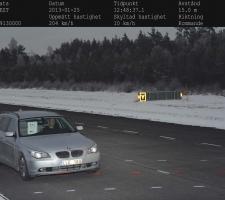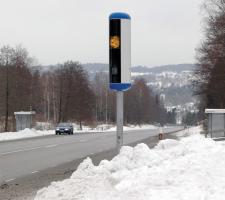
Images of speeding drivers are compared with photographic government records
In sharp contrast to many other countries drivers in Sweden support speed cameras and the planned expansion of the automated enforcement network.
Sweden is embarking on a massive expansion of its speed camera network and is doing so with both a very high level of public acceptance and without its drivers feeling persecuted; a feat the administrations in many other countries would like to emulate. So how did this envious state of affairs come about? Magnus Ferlander director of business development and marketing at Swedish enforcement system supplier Sensys, explains the background.
“One of the first things to say is that this latest expansion has its basis back in 1994 when the Vision Zero concept was introduced. Vision Zero basically says that the loss of life in road accidents is unacceptable and to achieve this, the road system must be designed in a way to take account of human error. In 1997 Vision Zero passed into Swedish law. This is very important because it is both an aim everybody can support and a clear statement of what the road and enforcement authorities are trying to achieve.”
It is also notable that by 2020, the stated aim of the Swedish-based car company609 Volvo is that nobody will be seriously injured or killed in one of its new vehicles and that in the longer term its cars should not crash at all.
However, Vision Zero is not Sweden’s only anomaly as it is also unique in enforcement terms in only allowing the prosecution of the individual driver rather than the vehicle. In practical terms this means that it is not sufficient to capture an offending vehicle’s number plate to prosecute the registered owner – there is a requirement to prove who was actually driving the vehicle at the time the offence was committed.
In the case of automated enforcement with speed cameras (Sweden does not allow red light cameras) this means the driver, as well as the number plate, must be recognisable. As a result, the equipment requirements differ substantially from those in other countries – Swedish supplier Sensys caters for this difference by using 36 megapixel cameras in its automated enforcement systems.
Across Sweden there are already 1,100 speed cameras on some 3,000km of roads. With this latest government announcement, by 2025 not only will most of those installations be updated, upwards of 2,000 additional cameras will also be added along another 6,000km of road. While the announcement has met with widespread public approval, Ferlander says that wasn’t the case before Vision Zero was introduced. “Before the turn of the century, the general perception for speed enforcement was low but now the approval rating among Swedish drivers is in the region of 75 – 80%. Much is this is exactly because the regulations put the emphasis on the road system and eliminates the feeling that the fines are just another form of tax on the motorist.”
Sensys has won the contract to supply the equipment for the forthcoming expansion and according to Ferlander the Swedish authorities may only activate the cameras for about 10% of the time although the radar-based speed measuring system works continuously. This enables the Swedish Transport Administration (6301 Trafikverket) to monitor actual vehicle speeds without drivers feeling they will be mercilessly penalised for every minor transgression.
He believes that ensuring that cameras are only positioned where they are required, and not only on major roads just because vehicles travel at higher speeds, also plays a major part in the improved approval rating in Sweden. “The records will identify where there are problems on the road and both drivers and the public will accept that it is reasonable to place a camera at that position.”
While many governments state that speed cameras should only be positioned where there is a proven need, the perception among drivers that they are simply a revenue raising device often remains. The UK is a case in point as government guidelines state that cameras should be restricted to roads with a history of traffic collisions, where there is evidence of a speeding problem or if there is local community concern. However, in a recent survey by the UK’s Institute of Advanced Motorists, more than half of the 1,000 motorists questioned disagreed with the statement: ‘Speed cameras are only sited at the places where accidents are happening.’
Whether the Swedish requirement to identify the individual driver and not just the vehicle is a significant difference in gaining public acceptance is less easy to define. When a speeding vehicle is captured on a camera in Sweden the first point of reference is still the number plate which is used to find the registered keeper’s name. Once the name has been established, the image of the speeding driver is compared with the keeper’s government-held photographic records (such as passport and driver’s licence).
If the errant driver and the registered keeper are identifiably the same person then a fine can be issued. Where they are clearly different people, the authorities would look at photo records of the registered keeper’s close family. Should it still not be possible to positively identify the driver, Ferlander says the authorities do have other methods of tracing the individual although ultimately the case may go unprosecuted. With such a high burden of proof, only around one third of Sweden’s recorded speeding violations end in a fine or a prosecution.
Part of this stems from the compulsory wearing of crash helmets, and lack of a front number plate, resulting in very few motorcyclists being prosecuted and a high court decision has ruled out average speed enforcement. This is because it would be impossible to prove that a particular individual had driven throughout the timed section.
Yet despite these shortcomings, overall adherence to speed limits in Sweden has improved from 50% in the late 1990s and currently stands at more than 80% in general and 95% at camera sites.
“This shows the approach is working and gaining public support,” says Ferlander.
Beyond Sweden, Sensys has recently secured supply contracts in Jordan, Saudi Arabia, the USA and Malta - so are others considering the face recognition route? Ferlander thinks not but does believe they appreciate the quality of the technology. “We concentrate on key aspects of our system and some of the authorities appreciate the imaging and data quality our systems produce.”
Asked why the implementation of enforcement cameras is reaching new countries he says some of the administrations are acting to reduce very high death tolls on their roads. In other cases new infrastructure or traffic management systems have provided roads on which motorists can speed whereas they had previously been prevented from speeding by heavy congestion.
As to where and how the cameras are positioned and used, he says all administrations are different, so what suits one will not be acceptable to another and adds that public acceptance is not always a key requirement.
“We try to assist our customers with mutual learning and from all angles it makes sense to put the cameras where they will do most good. From our viewpoint that means looking at the available records and data and listening to the views of local communities,” he says, adding: “And we know this is also a convincing argument for both motorists and the public.”
The UK’s Royal Automobile Club Foundation recently analysed data for 551 fixed speed cameras in nine areas. Its findings reveal that the average number of fatal and serious collisions in the vicinity of a speed camera fell on average by more than a fifth (22%) after the camera was installed. There was also an average post-installation reduction of 14% in personal injury collisions in the vicinity of a speed camera.
When evaluating the financial benefit derived from speed cameras, the savings from preventing the accidents and injuries far outweighs the revenue raised by levying fines on speeding drivers.
In 2005 an evaluation of the four-year benefit of implementing speed cameras in the UK found a positive cost-benefit of around 2.7:1. In the fourth year, the benefit to society from the avoided injuries was estimated to be in excess of £258million compared to enforcement costs of around £96million.
Sweden is embarking on a massive expansion of its speed camera network and is doing so with both a very high level of public acceptance and without its drivers feeling persecuted; a feat the administrations in many other countries would like to emulate. So how did this envious state of affairs come about? Magnus Ferlander director of business development and marketing at Swedish enforcement system supplier Sensys, explains the background.
“One of the first things to say is that this latest expansion has its basis back in 1994 when the Vision Zero concept was introduced. Vision Zero basically says that the loss of life in road accidents is unacceptable and to achieve this, the road system must be designed in a way to take account of human error. In 1997 Vision Zero passed into Swedish law. This is very important because it is both an aim everybody can support and a clear statement of what the road and enforcement authorities are trying to achieve.”
It is also notable that by 2020, the stated aim of the Swedish-based car company
However, Vision Zero is not Sweden’s only anomaly as it is also unique in enforcement terms in only allowing the prosecution of the individual driver rather than the vehicle. In practical terms this means that it is not sufficient to capture an offending vehicle’s number plate to prosecute the registered owner – there is a requirement to prove who was actually driving the vehicle at the time the offence was committed.
In the case of automated enforcement with speed cameras (Sweden does not allow red light cameras) this means the driver, as well as the number plate, must be recognisable. As a result, the equipment requirements differ substantially from those in other countries – Swedish supplier Sensys caters for this difference by using 36 megapixel cameras in its automated enforcement systems.
Across Sweden there are already 1,100 speed cameras on some 3,000km of roads. With this latest government announcement, by 2025 not only will most of those installations be updated, upwards of 2,000 additional cameras will also be added along another 6,000km of road. While the announcement has met with widespread public approval, Ferlander says that wasn’t the case before Vision Zero was introduced. “Before the turn of the century, the general perception for speed enforcement was low but now the approval rating among Swedish drivers is in the region of 75 – 80%. Much is this is exactly because the regulations put the emphasis on the road system and eliminates the feeling that the fines are just another form of tax on the motorist.”
Sensys has won the contract to supply the equipment for the forthcoming expansion and according to Ferlander the Swedish authorities may only activate the cameras for about 10% of the time although the radar-based speed measuring system works continuously. This enables the Swedish Transport Administration (
He believes that ensuring that cameras are only positioned where they are required, and not only on major roads just because vehicles travel at higher speeds, also plays a major part in the improved approval rating in Sweden. “The records will identify where there are problems on the road and both drivers and the public will accept that it is reasonable to place a camera at that position.”
While many governments state that speed cameras should only be positioned where there is a proven need, the perception among drivers that they are simply a revenue raising device often remains. The UK is a case in point as government guidelines state that cameras should be restricted to roads with a history of traffic collisions, where there is evidence of a speeding problem or if there is local community concern. However, in a recent survey by the UK’s Institute of Advanced Motorists, more than half of the 1,000 motorists questioned disagreed with the statement: ‘Speed cameras are only sited at the places where accidents are happening.’
Whether the Swedish requirement to identify the individual driver and not just the vehicle is a significant difference in gaining public acceptance is less easy to define. When a speeding vehicle is captured on a camera in Sweden the first point of reference is still the number plate which is used to find the registered keeper’s name. Once the name has been established, the image of the speeding driver is compared with the keeper’s government-held photographic records (such as passport and driver’s licence).
If the errant driver and the registered keeper are identifiably the same person then a fine can be issued. Where they are clearly different people, the authorities would look at photo records of the registered keeper’s close family. Should it still not be possible to positively identify the driver, Ferlander says the authorities do have other methods of tracing the individual although ultimately the case may go unprosecuted. With such a high burden of proof, only around one third of Sweden’s recorded speeding violations end in a fine or a prosecution.
Part of this stems from the compulsory wearing of crash helmets, and lack of a front number plate, resulting in very few motorcyclists being prosecuted and a high court decision has ruled out average speed enforcement. This is because it would be impossible to prove that a particular individual had driven throughout the timed section.
Yet despite these shortcomings, overall adherence to speed limits in Sweden has improved from 50% in the late 1990s and currently stands at more than 80% in general and 95% at camera sites.
“This shows the approach is working and gaining public support,” says Ferlander.
Beyond Sweden, Sensys has recently secured supply contracts in Jordan, Saudi Arabia, the USA and Malta - so are others considering the face recognition route? Ferlander thinks not but does believe they appreciate the quality of the technology. “We concentrate on key aspects of our system and some of the authorities appreciate the imaging and data quality our systems produce.”
Asked why the implementation of enforcement cameras is reaching new countries he says some of the administrations are acting to reduce very high death tolls on their roads. In other cases new infrastructure or traffic management systems have provided roads on which motorists can speed whereas they had previously been prevented from speeding by heavy congestion.
As to where and how the cameras are positioned and used, he says all administrations are different, so what suits one will not be acceptable to another and adds that public acceptance is not always a key requirement.
“We try to assist our customers with mutual learning and from all angles it makes sense to put the cameras where they will do most good. From our viewpoint that means looking at the available records and data and listening to the views of local communities,” he says, adding: “And we know this is also a convincing argument for both motorists and the public.”
The UK’s Royal Automobile Club Foundation recently analysed data for 551 fixed speed cameras in nine areas. Its findings reveal that the average number of fatal and serious collisions in the vicinity of a speed camera fell on average by more than a fifth (22%) after the camera was installed. There was also an average post-installation reduction of 14% in personal injury collisions in the vicinity of a speed camera.
When evaluating the financial benefit derived from speed cameras, the savings from preventing the accidents and injuries far outweighs the revenue raised by levying fines on speeding drivers.
In 2005 an evaluation of the four-year benefit of implementing speed cameras in the UK found a positive cost-benefit of around 2.7:1. In the fourth year, the benefit to society from the avoided injuries was estimated to be in excess of £258million compared to enforcement costs of around £96million.














